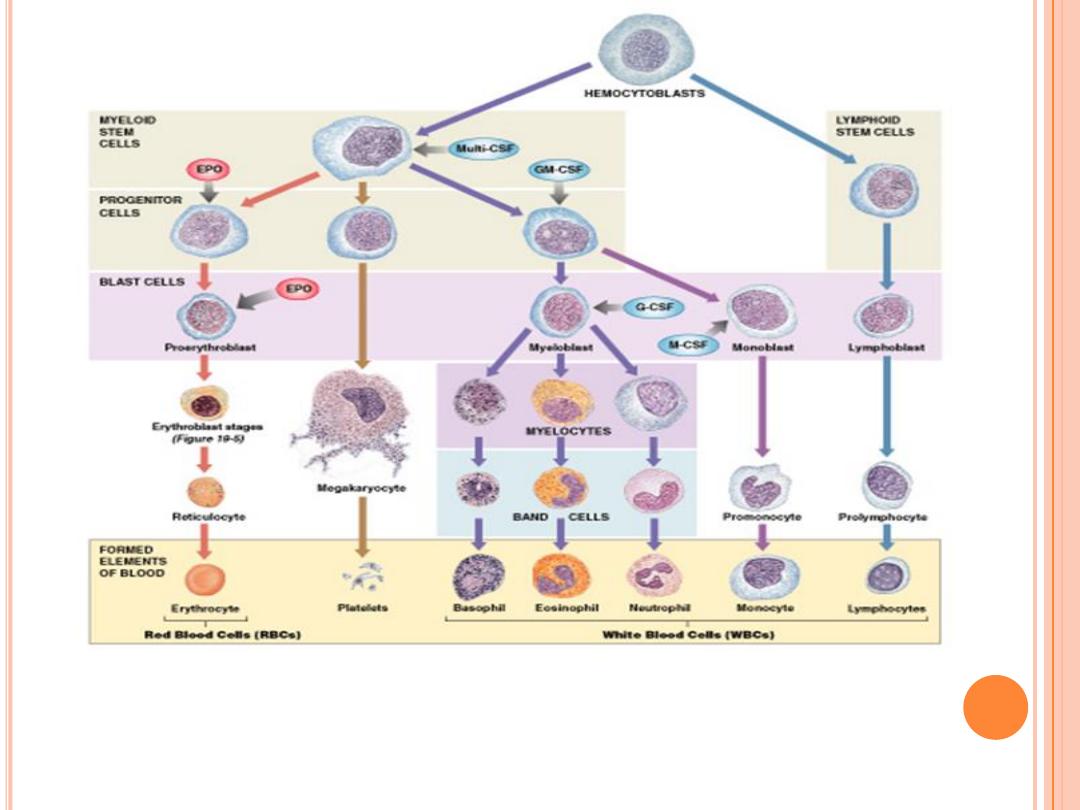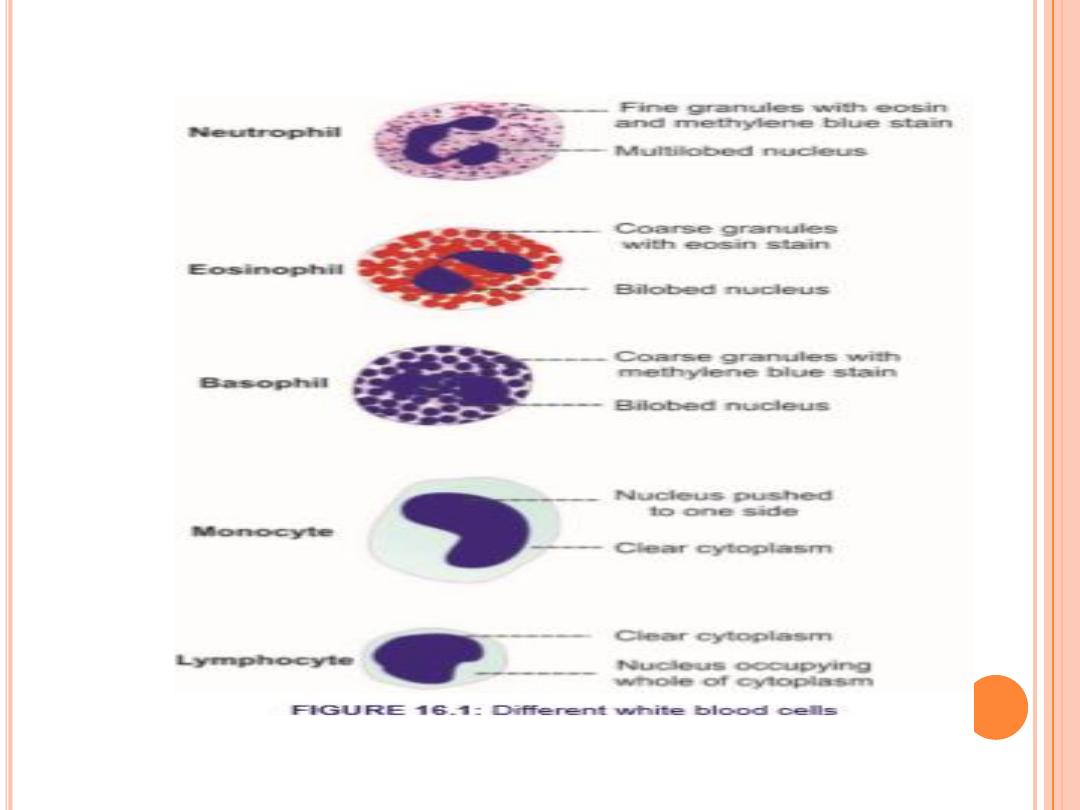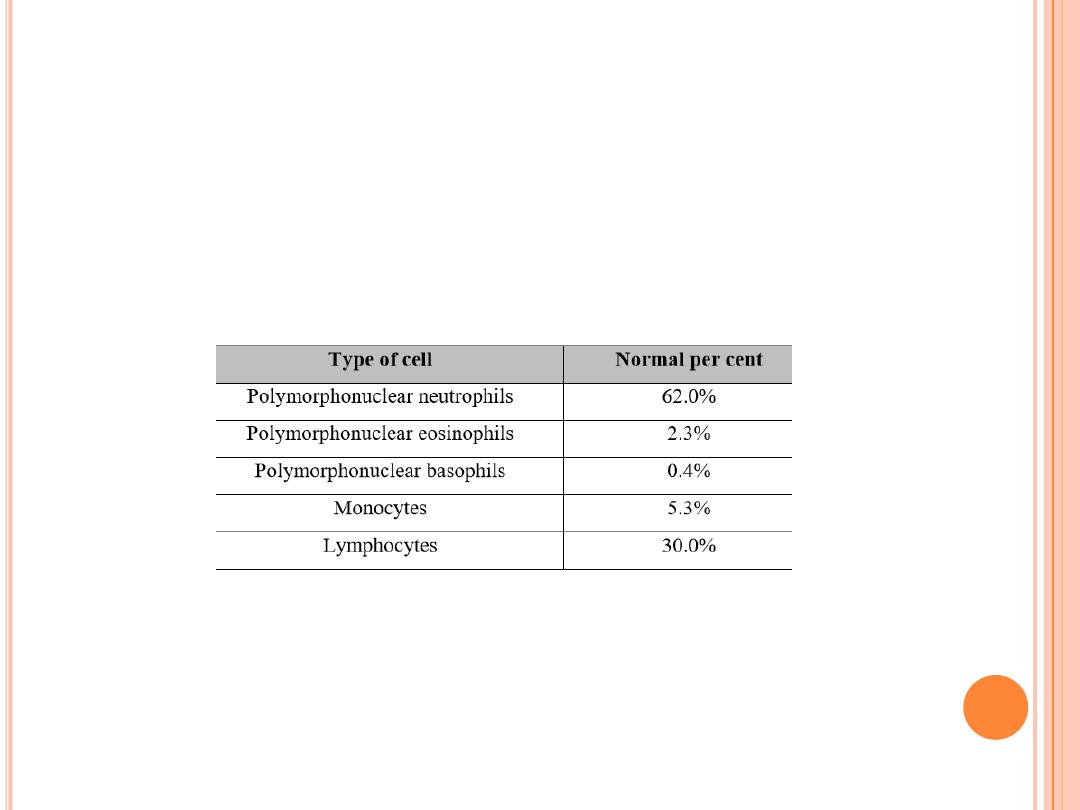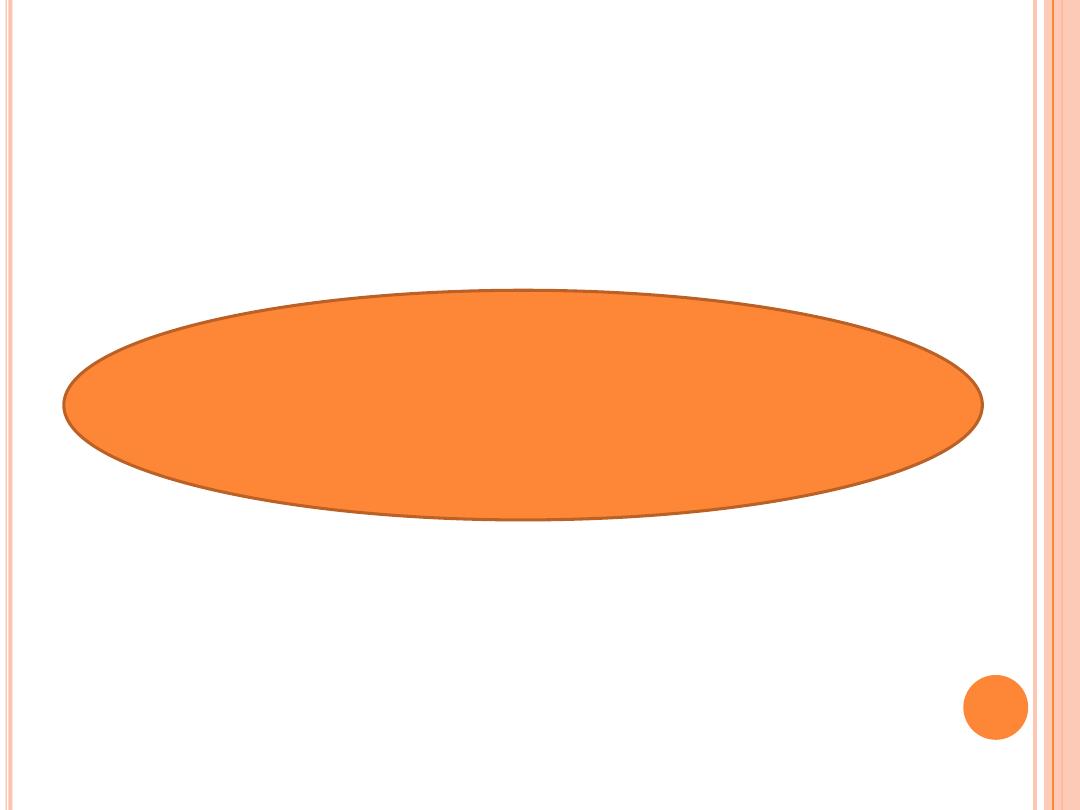
Physiology
Of blood

WBCs Leucocyte
Lect. 6

The leukocytes, also called white blood cells, are the mobile units of
the body’s protective system. They are formed
partially
in the bone
marrow (
granulocyte and monocytes
) and
partially
in the lymph
tissue (
lymphocytes and plasma cells
).
Six types of WBCs
are normally present in the blood.
1.Polymorphonuclear
Neutrophils
they have granular cytoplasm
2. Polymorphonuclear
Eosinophils,
3.Polymorphonuclear
Basophils,
4.
Monocytes,
5.
Lymphocytes
,
with the immune system..
6.
Plasma cells
.
***The granulocytes and monocytes protect the body against
invading organisms mainly by ingesting them— phagocytosis.

WBCs are the colorless and
nucleated
formed elements
of blood
Compared to
RBCs,
the
WBCs
are larger in size and
lesser in number, have a role in defense mechanism of
body and protect the body from invading organisms .
The differences between
WBCs and RBCs are:
1.
Larger in size.
2.
2. Irregular in shape.
3.
3. Nucleated.
4.
4. Many types.
5.
5. Granules are present in some type of WBCs.
6.
6. Lifespan is shorter.

O
RIGINS AND
D
IFFERENTIATION OF
F
ORMED
E
LEMENTS
All blood cells originate from
hemocytoblasts:
which produce myeloid stem cells and lymphoid stem
cells
Myeloid Stem Cells
Differentiate into progenitor cells:
which produce all WBCs except lymphocytes
Lymphocytes
Are produced by lymphoid stem cells
Lymphopoiesis: the production of lymphocytes.
WBCs, except monocytes: develop fully in bone
marrow i. e develop into macrophages in peripheral
tissues


Hormones that regulate blood cell populations:
Colony-Stimulating Factors (CSFs)
1.
M-CSF:
stimulates monocyte production
2.
G-CSF:
stimulates granulocyte production
neutrophils, eosinophils, and basophils
3.
GM-CSF:
stimulates granulocyte and
monocyte production
4.
Multi-CSF:
accelerates production of
granulocytes, monocytes, platelets, and RBCs

„
CLASSIFICATION
Based on the presence or absence of granules in the
cytoplasm, the leukocytes are classified into two groups:
1.
Granulocytes
which have granules.
2.
Agranulocytes
which do not have granules
**Granulocytes
Depending upon the staining property of granules, the
granulocytes are classified into three types:
i. Neutrophils with granules taking both acidic and
basic stains.
ii. Eosinophils with granules taking acidic stain.
iii. Basophils with granules taking basic stain.
** Agranulocytes
have plain cytoplasm without granules
are of two types:
i.
Monocytes.
ii.
ii. Lymphocytes


C
ONCENTRATIONS OF THE
D
IFFERENT
W
HITE
B
LOOD
C
ELLS IN THE
B
LOOD
.
The adult human being has about
7000 white
blood cells per microliter
of blood (in comparison with
5 million red
blood cells). Of the total
white blood cells, the normal percentages of the different types are
approximately the following:
Circulating WBCs
Migrate out of bloodstream
Have amoeboid movement
Attracted to chemical stimuli (positive chemotaxis)
Some are phagocytic: as neutrophils, eosinophils, and monocytes

L
IFE
S
PAN OF THE
W
HITE
B
LOOD
C
ELLS
The life of the
granulocytes
after being released
from the bone marrow is normally
4 to 8 hours
circulating in the blood and another
4 to 5 days
in
tissues where they are needed.
The
monocytes
have a short time, 10 to 20 hours in
the blood. Once in the tissues, they swell to much
larger sizes to become
tissue macrophages
, can live for
months unless destroyed while performing phagocytic
functions.

It is mainly the
neutrophils and tissue macrophages
that
attack and destroy invading bacteria, viruses, and other
injurious agents by a
phagocytosis,
which means cellular
ingestion of the offending agent.
The neutrophile has a lysosomal enzymes & bactericides
(hydrogen peroxide and superoxide)
The macrophage are much more powerful phagocytes than
neutrophils, often capable of phagocytizing as many as 100
bacteria with the ability to engulf much larger particles,
even whole RBCs or, occasionally, malarial parasites,
whereas neutrophils are not capable of phagocytizing
particles much larger than bacteria.

Eosinophils
are weak phagocytes, they are
produced in large numbers in people with
parasitic infections, and they migrate in large
numbers into tissues diseased by parasites , and
allergic reactions as in bronchial tissues of the
lungs in people with asthma
The
basophils
play an important role in some
types of allergic reactions that its release
histamine, bradykinin and serotonin
. basophils
liberate
heparin
into the blood, a substance that
can prevent blood coagulation.
The mast cells and basophils play an important
role in some types of allergic reaction because the
type of antibody that causes allergic reactions, the
immunoglobulin E
(IgE)
type, has a special
propensity to become attached to mast cells and
basophils.

L
YMPHOCYTES
Lymphocytes enter the circulatory system continually, the lymphocytes
have life spans of weeks or months; this depends on the body’s need for
these cells.
3 Types :
1.
T cells
2.
B cells
3.
Natural killer (NK) cells
T- Cells
Cell-mediated immunity
Attack foreign cells directly
B-Cells
Humoral immunity
Differentiate into plasma cells (activated B cells that secrete
antibodies).
Synthesize antibodies
Natural Killer Cells (NK)
Detect and destroy abnormal tissue cells (cancers)

„
NORMAL WHITE BLOOD CELL COUNT
Total WBC count : 4,000 to 11,000/cu mm of
blood.
Leukopenia:
abnormally low WBC count
Leukocytosis:
abnormally high WBC count
Leukemia:
extremely high WBC count

PHYSIOLOGICAL VARIATIONS
1. Age: WBC count is about
20,000 per cu
mm in
infants
and about
10,000 to 15,000 per cu
mm of
blood in
children
. In adults, it ranges between
4,000 and 11,000 per cu mm of blood.
2. Sex: Slightly more in males than in females.
3. Diurnal variation: Minimum in early morning
and maximum in the afternoon.
4. Exercise: Increases slightly.
5. Sleep: Decreases.
6. Emotional conditions like anxiety: Increases.
7. Pregnancy: Increases.
8. Menstruation: Increases.

„
PATHOLOGICAL VARIATIONS
All types of leukocytes do not share equally in the
increase or decrease of total leukocyte count. In
general, the neutrophils and lymphocytes vary in
opposite directions.
Leukocytosis
occurs in conditions such as:
1. Infections 2. Allergy 3. Common cold 4. Tuberculosis 5.
Glandular fever.
Leukemia
is the condition which is characterized by
abnormal and uncontrolled increase in leukocyte count
more than 1,000,000/cu mm. It is also called blood
cancer.
Leukopenia
is the decrease in the total WBC count ,
occurs in :
1. Anaphylactic shock 2. Cirrhosis of liver 3. Disorders of
spleen 4. Pernicious anemia 5. Typhoid and paratyphoid
6. Viral infections.

Thank you
